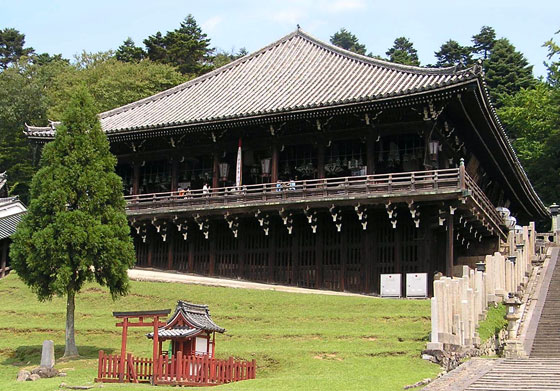|
||
 |
||

Toudaiji Nigatsudou 東大寺二月堂 (Nara)
(C)2001 Japanese Architecture and Art Net Users System. No reproduction or republication without written permission.
掲載のテキスト・写真・イラストなど、全てのコンテンツの無断複製・転載を禁じます。
|
||||||
| Nigatsudou 二月堂 | ||||||
| KEY WORD : architecture / buildings & structures | ||||||
| Lit. second month hall. A temple widely known for its famous ancient festival called omizutori お水取り in March. Originally held from February 1st to 14th on the old calendar and formerly called shunie 修二会. It is a ritual to scoop up the first water from the Wakasa 若狭 well, in the front of the Nigatsudou. Prayers are said for the prosperity of the country. A large hall constructed in the overhang style kake-zukuri 懸造, in the grounds of Toudaiji 東大寺, in Nara. It is 7 bays wide×10 bays deep. It measures 22.46m×27.19m. There are bracket complexes *tokyou 斗きょう, of the one-stepped type *degumi 出組, intercolumnar spaces that have struts capped with bearing blocks *kentozuka 間斗束, and on the lower part there are 3-stepped bracket complexes *mitesaki tokyou 三手先斗きょう. The double eaves *futanoki 二軒, and rafters *shigedaruki 繁垂木, are closely spaced. Across the front and on two sides, there are open verandas equal to two bays in width. This part is called the *raidou 礼堂. The entire building is covered with a hipped roof *yosemune-zukuri 寄棟造. Although largely wayou style *wayou 和様, the hall has elements of both the Zen style *zenshuuyou 禅宗様, and daibutsu style *daibutsuyou 大仏様. The three styles are well integrated. It is said that the second head priest Jitchuu 実忠, built the original structure in 752. However the present building dates from 1699 and was constructed by Tokugawa Ietsuna 徳川家綱 (1641-80). | ||||||
 Toudaiji Nigatsudou 東大寺二月堂 (Nara) |
||||||
| REFERENCES: | ||||||
| EXTERNAL LINKS: | ||||||
| NOTES: | ||||||
(C)2001 Japanese Architecture and Art Net Users System. No reproduction or republication without written permission. 掲載のテキスト・写真・イラストなど、全てのコンテンツの無断複製・転載を禁じます。 |
||||||